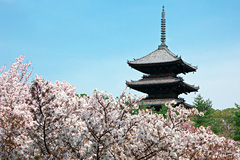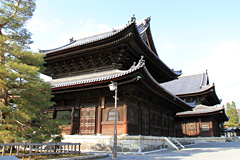Posted on Oct 3, 2013 in Daytrips, Must see, Things to do, Weekend trips |
Kyoto, the city of samurai moviesIntroduction of Kyoto, a city associated with the master of classic Japanese cinema, Kenji Mizoguchi, and his movies, that even those who are new to Japanese cinema can enjoy
Kyoto is the Hollywood of samurai movies so to speak, with many temples and shrines in the city being used for shooting movies and having a studio for Japanese period dramas. Moreover, the city is noted in connection with Kenji Mizoguchi, one of the greatest movie directors in Japan, who influenced filmmakers of the world including Godard with his works such as “Ugetsu”. Nobuyoshi Nishida, a movie and book producer who has worked on collections of the works of Kenji Mizoguchi will introduce sites such as a theme park, movie locations, and a temple associated with Mizoguchi that is registered as a World Heritage site that can be enjoyed by any Japanese period drama fan.
 Samurai movie Hollywood, packed with World Heritage Sites
Samurai movie Hollywood, packed with World Heritage Sites
Kyoto is one of the largest tourist spots in Japan, where many World Heritage Sites such as Nijo Castle and
Kiyomizu-dera,
Kinkaku-ji and Ginkaku-ji temples are concentrated. In addition, the city has many sites for fans of Japanese period dramas, as it is the main shooting location for samurai movies.

In particular, the northern part of Ukyo-ku, the largest ward in western
Kyoto City, is an area that Japanese period drama fans cannot miss. In addition to a period drama theme park where visitors can take a tour of a studio for period dramas and real movie sets, there is
Myoshin-ji Temple, which is the main temple of approximately 3,400 Myoshin-ji branches of the Rinzai School of Zen Buddhism throughout Japan and often appears in Japanese period dramas. If you are a Japanese period drama fan, you might have seen the temple on a movie screen, as it is still used often as a location for filming swordfights or other scenes in samurai movies.
Ninnaji Temple is also another World Heritage Site, located right by Omuro-Ninnaji Station on the Keifuku Railway Kitano Line, one stop after Myoshinji Station. Ninnaji Temple was favored by Director Kenji Mizoguchi, the master of classic Japanese cinema who won awards at the Venice Film Festival for three consecutive years for his works “
The Life of Oharu“, “Ugetsu” and “Sansho the Bailiff”, which were highly praised by French New Wave directors including Jean-Luc Godard. Though the temple becomes crowded in spring as it is famous for beautiful cherry blossoms, it is fairly quiet in other seasons. There are many sights to see within the temple premises, including the Kon-do (Golden Hall), which is a
National Treasure of Japan, Nio-mon Gate, located at the entrance, the vermilion-lacquered Chu-mon Gate, and a Five-Storied Pagoda, along with a garden that takes on a different look with each season.

- Kenji Mizoguchi-directed film “The Cuckoo” (1927)
Kenji Mizoguchi-directed film “The Cuckoo” (1927)Mizoguchi was especially fond of the area called “Omuro”, which includes Ninnaji Temple and its surrounding area. He lived in a rental house near Ninnaji Temple for a long time, and made his home in this area in his later years. He is known for a technique that captures more details including the surrounding ambience using long-takes, and influenced the Greek filmmaker Theodoros Angelopoulos, who directed “The Travelling Players”, which is one of the greatest masterpieces of global film history. Ninnaji Temple and its surrounding area are filled with the graceful atmosphere of Mizoguchi films.
 Samurai movie Hollywood, packed with World Heritage Sites
Samurai movie Hollywood, packed with World Heritage Sites







